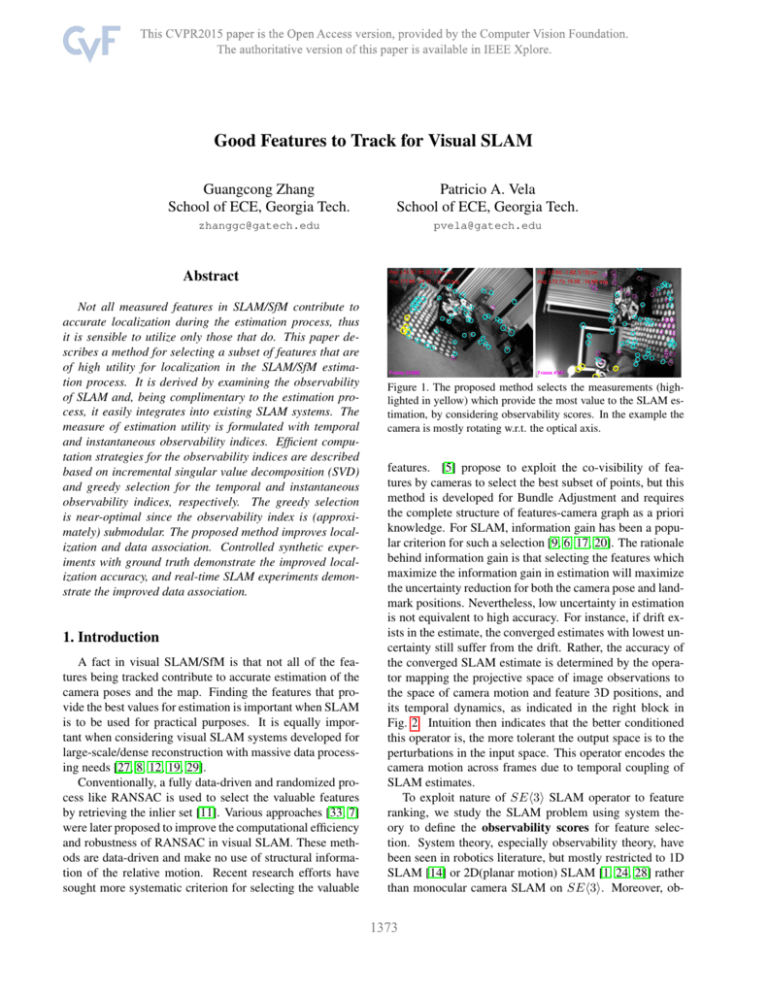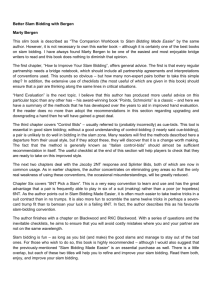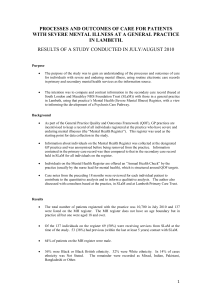Good Features to Track for Visual SLAM
advertisement

Good Features to Track for Visual SLAM
Guangcong Zhang
School of ECE, Georgia Tech.
Patricio A. Vela
School of ECE, Georgia Tech.
zhanggc@gatech.edu
pvela@gatech.edu
Abstract
Not all measured features in SLAM/SfM contribute to
accurate localization during the estimation process, thus
it is sensible to utilize only those that do. This paper describes a method for selecting a subset of features that are
of high utility for localization in the SLAM/SfM estimation process. It is derived by examining the observability
of SLAM and, being complimentary to the estimation process, it easily integrates into existing SLAM systems. The
measure of estimation utility is formulated with temporal
and instantaneous observability indices. Efficient computation strategies for the observability indices are described
based on incremental singular value decomposition (SVD)
and greedy selection for the temporal and instantaneous
observability indices, respectively. The greedy selection
is near-optimal since the observability index is (approximately) submodular. The proposed method improves localization and data association. Controlled synthetic experiments with ground truth demonstrate the improved localization accuracy, and real-time SLAM experiments demonstrate the improved data association.
Figure 1. The proposed method selects the measurements (highlighted in yellow) which provide the most value to the SLAM estimation, by considering observability scores. In the example the
camera is mostly rotating w.r.t. the optical axis.
features. [5] propose to exploit the co-visibility of features by cameras to select the best subset of points, but this
method is developed for Bundle Adjustment and requires
the complete structure of features-camera graph as a priori
knowledge. For SLAM, information gain has been a popular criterion for such a selection [9, 6, 17, 20]. The rationale
behind information gain is that selecting the features which
maximize the information gain in estimation will maximize
the uncertainty reduction for both the camera pose and landmark positions. Nevertheless, low uncertainty in estimation
is not equivalent to high accuracy. For instance, if drift exists in the estimate, the converged estimates with lowest uncertainty still suffer from the drift. Rather, the accuracy of
the converged SLAM estimate is determined by the operator mapping the projective space of image observations to
the space of camera motion and feature 3D positions, and
its temporal dynamics, as indicated in the right block in
Fig. 2. Intuition then indicates that the better conditioned
this operator is, the more tolerant the output space is to the
perturbations in the input space. This operator encodes the
camera motion across frames due to temporal coupling of
SLAM estimates.
To exploit nature of SEh3i SLAM operator to feature
ranking, we study the SLAM problem using system theory to define the observability scores for feature selection. System theory, especially observability theory, have
been seen in robotics literature, but mostly restricted to 1D
SLAM [14] or 2D(planar motion) SLAM [1, 24, 28] rather
than monocular camera SLAM on SEh3i. Moreover, ob-
1. Introduction
A fact in visual SLAM/SfM is that not all of the features being tracked contribute to accurate estimation of the
camera poses and the map. Finding the features that provide the best values for estimation is important when SLAM
is to be used for practical purposes. It is equally important when considering visual SLAM systems developed for
large-scale/dense reconstruction with massive data processing needs [27, 8, 12, 19, 29].
Conventionally, a fully data-driven and randomized process like RANSAC is used to select the valuable features
by retrieving the inlier set [11]. Various approaches [33, 7]
were later proposed to improve the computational efficiency
and robustness of RANSAC in visual SLAM. These methods are data-driven and make no use of structural information of the relative motion. Recent research efforts have
sought more systematic criterion for selecting the valuable
1
Figure 2. Overview of our approach. The proposed method can be plugged in as a sub-step in the SLAM process. In a time step (T3 in
the figure), for features which are initially matched, we first examine the rank conditions for them, i.e. whether the feature is completely
observable to the SLAM system. If rank condition a feature is satisfied (depicted in green/purple), the τ -temporal observability score is
evaluated by considering the relative motion of the feature in the past τ local frames. Features with high observability scores are selected
as ‘good’features (depicted in green). If the number of highly observable features is too few, feature grouping with a submodular learning
scheme is applied to collect more good features. These subset of good features provide the near-optimal value for SLAM estimation.
timates across time (in terms of accuracy and robustness to
noise). This subset is selected by ranking features according
to their contribution to system observability (higher system
observability means better conditioned estimation). In order
to formulate the ranking score for each feature, the SLAM
system is first modeled with SEh3i motion. The score is
then formulated based on the observability of the subsystem composed of the camera and each individual feature.
servability theory has mainly been for full rank observability condition analysis, much as in [34] which analyzes
bearings-only SLAM. For visual SLAM on SEh3i, [26]
provides an analysis of observability, but it is for stereovision SLAM with planar displacement. [32] discusses observability tests for camera ego-motion from perspective
views at time instances. Few works use observability in
algorithm design rather than merely observable condition
analysis /observability tests. [18] presented a framework for
improving the consistency of EKF-based planar SLAM by
finding linearization points that ensure the observable subspace is of appropriate dimension for the linearized system.
Contribution. Using systems theory, we develop a feature ranking criterion for selecting the features which provide good conditioning for visual SLAM ego-motion estimation. The overview of our method is depicted in Fig. 2.
This paper has three major contributions: we (1) propose a
feature ranking criterion based on observability scores using a complete observability condition for SEh3i SLAM;
(2) describe an efficient algorithm for computing temporal
observability based on incremental SVD; and (3) describe
an efficient algorithm for computing instantaneous observability via submodular learning. The algorithm is called the
Good Features algorithm and can be integrated into most
existing SLAM implementations to arrive at GF-SLAM.
The contributions lead to performance gains regarding egomotion estimation and data-association in visual SLAM,
which are shown via experiments.
2.1. Motion and Observations for SEh3i SLAM
Here, the SLAM scenario with features and anchors is
considered. The SLAM system dynamics are modeled under the hybrid SEh3i state common to robotics (position in
world frame W , with orientation in body frame R ) [25],
with a perspective camera measurement model.
2.1.1
Dynamic and Measurement Models
For a system with discrete observations, a constant velocity
motion model suffices [11]. Accordingly, given the SEh3i
W
position and orientation rW
Rk , qRk (vector, quaternion), and
associated velocities vRWk , ω R , at time k, the camera state
rW
=
xW
Rk
Rk
qW
Rk
vRWk
ωR
>
is updated per:
W + VW )∆t
rW
Rk + (vR
k
qW × exp ω R + ΩR ∆t
Rk
,
=
vRWk + VW
R
R
ω +Ω
2. Good Features to Track for Visual SLAM
xW
Rk+1
Let F be the set of features being tracked during the
monocular SLAM process. Much like [30] sought good
features within an image for data association across frames,
the Good Features algorithm here aims to find the subset of
features which aids most the SLAM camera ego-motion es-
where VW , ΩR are zero-mean Gaussian noise. The mea3
surement model for the i-th feature (i) pW
k ∈ R is pinhole
2
Lamma 1. [15] A discrete PWLS is completely observable
iff the Total Observability Matrix (TOM) is full-rank.
projection:
(i)
pRk
R
hi k
−1 Rk
Rk Rk Rk >
W
(i) W
= [px , py , pz ] = RW
qRk
pk − rW
Rk ,
Rk
u0 − f ku pRxk
pz
= Distort
(1)
R ,
fp k
v0 − f kv Ryk
QTOM (j) =
n−1 n−1
n−1
Qr Fr−1 Fr−2 · · · F1
pz
where R(q) is the rotation matrix of q; f ku , f kv , u0 , v0 are
the camera intrinsic parameters; and Distort[·] is nonlinear
image distortion [10].
2.1.2
Computation of the TOM is expensive. However, for the
SLAM system described in Equation 3, N (Qj ) ⊂ N (Fj ).
Lemma 2 provides a proxy to examine the full rank condition of the system
Assume the system has Nf features and Na anchors. An
anchor is a 3D point in W whose position is known and
is not included in estimation process, while a feature is 3D
point whose position is not certain (at least initially). Both
are observed by the camera as per Equation (1). For the k-th
time segment Tk ≡ [tk , tk+1 ) (from time k to time k + 1),
the dynamics of the whole system with input uk are
!
W xW
xRk W
W
R
k+1
Xk+1 ,
(2a)
=f
Ak + uk ,
PW
PW
k
k+1
W xRk W
Rk+1
Rk+1
h
=h
(2b)
Ak ,
PW
k
Lamma 2. [15] For PWLS, when N (Qj ) ⊂ N (Fj ), the
stripped Observability Matrix (SOM)
>
> >
QSOM (j) = Q>
.
1 |Q2 | · · · |Qj
for t ∈ Tk
(5)
has the same nullspace as TOM, i.e. N (QSOM (j)) =
N (QTOM (j)).
Theorem 1. When Nf = 0, a necessary condition for system (3) to be completely observable within J is (1) J = 1
and Na ≥ 3, or (2) J ≥ 2 and Na ≥ 1.
(2) W
>
where PW
, ((1) pW
pk , ..., (Nf ) pW
∈ R3Nf
k
k ,
k )
is the map state vector by stacking the feature vectors,
(1) W (2) W
>
3Na
is the anchor
AW
ak , ak , ..., (Na ) aW
k , (
k ) ∈ R
R
R
R
k+1
k+1
state vector, and hRk+1 , (h1 , h2 , ..., hNk+1 )> ∈
I2(Nf +Na ) is the measurement vector at time k + 1 with
measurements from both features and anchors.
With the smooth motion assumption,
the system at Tk
W + Df XW · XW + u ,
is linearized via XW
u
X
k
k+1
k
k
k
R
R
R
W
W
k+1
k
k+1
h
u h + Dh
Xk · Xk . The linearized systems across time segments form the piece-wise linear system (PWLS) in (3) below, which approximates the timevarying system in (2).
Rk W
XW
k+1 = F Xk + uk
δhRk = HRk XW
k
(4)
where Fj is the process matrix and Hj is the measurement
matrix for time segment j. Qj is the linear observability
n−1 >
>
>
) .
matrix, Q>
j = Hj |(Hj Fj ) | · · · |(Hj Fj
Piece-wise Linear System (PWLS) modeled for
SLAM
Q1
Q2 F1n−1
..
.
Proof. The SLAM system with Nf features and Na anchors has the PWLS matrices
!
013×3Nf
FxW
Rk
Rk
F =
,
(6)
03Nf ×13 I3Nf ×3Nf
and
FxW
Rk
I3×3
= 04×3
06×7
03×4
Q4×4
∆t · I3×3
04×3
I6×6
03×3
Ω4×3
(7)
where Q and Ω are defined as
(3)
qR
qx
Q=
qy
qz
R
qk
qx
Ω = ky
qk
qkz
The PWLS preserves the characteristic behavior of the original time-varying system with little loss of accuracy [15].
2.2. System Observability Measure
For a discrete PWLS, the sufficient and necessary condition for the system to be completely observable is given by
the following Lemma:
with qW
Rk
3
=
−q x
qR
−q z
qy
−q y
qz
qR
−q x
−qkx
qkR
qkz
−qky
−qky
−qkz
qkR
qkx
−q z
y
−q
, and
qx
R
q
−qkz
y
qk dq
· ∆t.
·
−qkx dω
R
qk
(qkR , qkx , qky , qkz )> and exp (ω R ∆t)
(8)
=
(q R, q x, q y, q z )> . The measurement Jacobian is
Rk
H
=
Rk
Rk
∂h1
∂h1
∂rW
R
∂qW
R
..
.
..
.
R
∂hNk
∂rW
R
Rk
∂qW
R
Rk
f
∂h(N +1)
f
∂h(N +1)
f
∂rW
R
∂qW
R
..
.
..
.
k
∂h(N
f +Na )
k
∂h(N
f +Na )
∂rW
R
∂qW
R
R
∂h1
∂pW
k
···
..
.
..
.
..
02×6
02×3
···
02×3
..
.
.
R
R
∂hNk
f
02×6
Rk
∂hNk
f
∂pW
k
02×6
..
.
R
02Na ×3Nf
02×6
F , each subblock in Q can be computed iteratively with
P
i
HFn = H1∼3 H4∼7 Qn H1∼3 n∆t H4∼7 n−1
i=0 Q Ω
(9)
where H1∼3 denotes the matrix consist of column 1 to column 3 of matrix H. Secondly, the running temporal observability score of a feature can be computed efficiently with
incremental SVD. Computation of the τ -temporal observability score is divided into the following phases:
.
1. In the first two frames that a feature is tracked, the observability cannot be full-rank. Build the SOM;
2. In frame three, the full rank condition of SOM may be
satisfied. Compute SVD of the SOM;
3. From frame 4 to frame τ +1 (in total τ time segments),
for each new time segment a block of linear observability matrix is added to the SOM. Instead of computing
SVD on the expanded SOM, perform a constant time
rank-k update of the SVD [4], as per below.
The SVD of QSOM (j) is U SV > = QSOM (j)> ,
where S ∈ Rr×r with r = 13 (camera state). For the
new row a>, compute
The first Nf rows are w.r.t. the features while the last
Na rows are w.r.t. the anchors. Using Equations (6) to
(9), the dimensions of null spaces within one time segment
when Nf = 0, Na 6= 0 can be obtained: When Na ≥ 3,
Dim(N (QSOM (1))) = 0 may hold, i.e. QSOM (1) is fullrank. Thus, the system (3) is completely observable. Similarly, when r ≥ 2 and Na ≥ 1, Dim(N (QSOM (j))) = 0
may hold, i.e. system is completely observable.
m , U> a; p , a − Um; P , p/||p||.
According to Theorem 1, if a feature is tracked across
3 frames, the system composed of the camera motion and
the feature may become observable, and the corresponding
SOM full-rank. Degenerate conditions such as the point lying on the translation vector of a camera undergoing pure
translation would fail to be observable (as would pure rotation). The degenerate conditions are typically of measure zero in the observation space. Tracking multiple features would guarantee observability for some subset of the
tracked set. Under the observable condition for a feature,
the value of a feature towards ego-motion estimation is reflected by the conditioning of the SOM. Thus, we define the
τ -temporal observability score of a feature across τ local
frames, τ ≥ 2 with the minimum singular value of SOM:
Let
K=
S m
.
0 ||p||
(10)
(11)
Diagonalize K as U0> KV0 = S0 and update
>
[QSOM (j)> |a] = ([U P]U0 )S0 ([V̄ Q]V0 )
>
>
(12)
>
where V̄ = [V , 0], Q = [0, · · · , 0, 1] . Diagonalization of K takes O(r2 ) [16].
Expanding the SOM with more time segments results in adding 2r new rows into SOM. Each new row
requires a rank-1 update, leading to rank-2r update for
the whole SOM.
4. After frame τ +1, for each new frame, update the SOM
by replacing the subblock from the oldest time segment with the linear observability matrix of the current time segment. For example, let SOM at time k
(k)
>
> >
be QSOM (τ ) = Q>
, then at
k−τ +1 |Qk−τ +2 | · · · |Qk
>
>
(k+1)
>
time k + 1, QSOM (τ ) = Qk+1 |Qk−τ +2 | · · · |Q>
.
k
ψ(f, τ ) = σmin (QSOM (τ |f )),
where at time k, QSOM (τ |f ) is defined on the time segments (k − τ ), (k − τ + 1), ..., k.
This temporal observability score measures how constrained the SLAM estimate is w.r.t. the feature observation
in the projective space, when considering the relative poses
of the feature and camera over a recent period of time. The
temporal nature of the measure is important because the
SLAM estimate, in both the filtering and smoothing versions, is performed across time, with the current estimate
affected by the previous estimate.
(k+1)
Computing the SVD of QSOM (τ ) given the SVD
(k)
of QSOM (τ ) can also be done with a rank-2r update
similar to phase 3. Let row b be replaced by row vector
c in this case, by setting a = (c−b)> , the updated SVD
is generated via (10)-(12).
After updating the τ -temporal observability scores of the
features and ranking them, the top Ka features over a selected threshold are upgraded to be anchors. If the anchor
set has less than (Ka − 2) elements passing the threshold
test, then additional features will need to be added to complete the anchor set.
2.3. Rank-k Temporal Update of Observability
Score
Computation of the τ -temporal observability score is efficient. Firstly, due to the sparse nature of the process matrix
4
Proof. (Theorem 2) WLOG consider the two row-blocks
R1 and R2 from R. Denote the Gram matrices G◦ as:
GX = X > X, GR1 = R1> R1 , and GR2 = R2> R2 .
Also define the augmented Gram matrices
as
X
>
>
GXR = X |R ·
R
It holds that GXR1 = GX + GR1 , GXR2 = GX + GR2 ,
GXR1 R2 = GXR1 + GR2 , and GXR2 R1 = GXR2 + GR1 .
Let the minimum eigenvalue of GX be λmin (GX ) ≡
λm (GX ), the maximum eigenvalue be λmax (GX ) ≡
2
λ1 (GX ). Since X is a real matrix, λmin (GX ) = σmin
(X),
and likewise for the augmented matrices. From Lemma 3,
λmin (GXR1 ) = λmin (GX + GR1 )
Figure 3. In spatial grouping, selecting one more feature as anchor
results in an additional row-block in the measurement Jacobian,
which further expands the SOM.
3. Submodular Learning for Feature Grouping
≥ (λmin (GX ) + λmin (GR1 ))
When needed, the group completion step selects more
features as anchors by maximizing the minimum singular
value of SOM over the selected features. Upgrading a feature to be an anchor will expand the dimension of F and H
in Equation (6)-(9), resulting in additional rows in SOM.
The group completion problem can be formulated as follows: Let X be the SOM of the features with high observability score, X ∈ Rn×m , n ≥ m. Adding a feature results in adding a row-block Rk to the SOM as in
Fig. 3. Denote the set of all candidate row-blocks as R =
0
{R1 , R2 , ..., RK }, Rk ∈ Rn ×m . Finding K ∗ features
which form the most observable SLAM subsystem is equivalent to finding a subset of the candidate rows that maximize
the minimum singular value of the augmented matrix
∗> >
R∗ =
argmax σmin X > |R1∗> |R2∗> |...|RK
∗
Thus, Fσmin (X ∪ {R1 }) ≥ Fσmin (X). From Lemma 4,
and the fact that the Gram matrices are real-symmetric and
hence Hermitian, the following holds:
λmin (GXR1R2 ) = λm+1−1 (GXR1R2 )
(17)
≤ λm (GXR2 ) + λ1 (GR1 )
Combining (16) and (17),
λmin (GX ) + λmin (GXR1R2 )
≤ λmin (GXR1 ) + λmin (GXR2 ) + dρ (R1 ),
where dρ (R1 ) = λmax (R1 ) − λmin (R1 ). Similarly,
λmin (GX ) + λmin (GXR1R2 )
≤ λmin (GXR1 ) + λmin (GXR2 ) + dρ (R2 )
R∗ ⊆R,|R∗ |=K ∗
The tighter bound is:
λmin (GX ) + λmin (GXR1R2 )
Such a combinatorial optimization problem is NP-hard.
However, the problem has nice submodular properties.
≤ λmin (GXR1 )+λmin (GXR2 )+min (dρ (R1 ), dρ (R2 )) .
Definition 1. [23] (Approximate submodularity)
A set function F : 2V 7→ R is approximately submodular if
for D ⊂ D0 ⊂ V and v ∈ V \ D0
This leads to
Fσmin (X ∪ {R1 }) + Fσmin (X ∪ {R2 })
≥ Fσmin (X) + Fσmin (X ∪ {R1 } ∪ {R2 })
F (D ∪ {v}) − F (D) ≥ F (D0 ∪ {v}) − F (D0 ) − ε (13)
− min (dρ (R1 ), dρ (R2 )) . (18)
Theorem 2. When X ∩ R = ∅, the set function Fσmin (·) :
2X∪R 7→ R is approximately submodular,
∗> >
Fσmin (X ∪ R∗ ) = σmin X > |R1∗> |R2∗> |...|RK
.
∗
(14)
When X ∩ R = ∅, Fσmin (·) is approximately submodular,
with the bound ε = max(dρ (Rk )), ∀Rk ∈ R.
Theorem 2 means that a greedy algorithm will be nearoptimal. The simplest greedy algorithm outline in Algorithm 1 identifies the group completion in the cardinality
deficient case with a complexity of O(K ∗ Kn0 ) (when using incremental SVD). The near-optimality bound is
The proof requires the following two lemmas.
Lamma 3. [3] (Concavity of min eigenvalue function)
For any real symmetric matrix G ∈ Rm×m , let f (G) ,
λmin (G), f (G) is a concave function of G.
Theorem 1. [23]. Let AG be the set of the first
K ∗ elements chosen by Algorithm 1, and let OP T =
max
Fσmin (X ∪ A). Then
A⊂R,|A|=K ∗
∗
K ∗ !
K −1
Fσmin (AG ) ≥ 1 −
(OP T − K ∗ ε)
K∗
(19)
Lamma 4. [13] (Eigenvalues of sum of two matrices) Let
A, B, C be Hermitian n by n matrices, denote the eigenvalues of A by α : α1 ≥ α2 ≥ ... ≥ αn , and similarly write
β and γ for eigenvalues of B and C, then:
γi+j−1 ≤ αi + βj whenever i + j − 1 ≤ n.
(16)
≥ λmin (GX )
(15)
5
Figure 4. Simulated scenario #1 for ego-motion estimation experiment. Results shown have 1.0 pixel measurement standard deviation and
Ka = 10. Row 1: reconstructed maps at time steps when camera is performing circular movement; features are depicted with estimated
mean and covariance; points in red are selected as anchors. Row 2: corresponding camera frames with observability scores shown for all
measurements. Row 3: interpolated maps of observability score on image plane showing how it changes during the motion.
ple, in 1-Point RANSAC method, for each iteration the
features with high observability scores are used to partially update the model, which is then used to retrieve
the inlier set.
Algorithm 1: Submodular learning for feature grouping.
Data: X ∈ Rn×m , n ≥ m,
R = {R1 , R2 , ..., RK }, Rk ∈ R1×m , K ∗
Result: R∗ , |R∗ | = K ∗
∗
1 R ← ∅;
∗
∗
2 while |R | < K do
∗
3
R ← arg maxR∗ ∈R Fσmin (X ∪ {R∗ });
4
R∗ ← R∗ ∪ {R∗ };
5
R ← R \ {R∗ };
4.2. Experiments for Ego-motion estimation
Evaluation of the proposed method for the ego-motion
estimation phase focuses on the estimation accuracy. Therefore this experiment will isolate the data association error
from the localization error such that the SLAM accuracy is
only affected by the selection of anchors. Precisely benchmarking the SLAM accuracy is a difficult task, because
most of the publicly available datasets do not provide exact
ground truth and perfect data association. The usual SLAM
baseline for evaluating accuracy is a global optimization,
usually bundle adjustment [2, 35]. However, these datadriven baseline methods are not actual ground truth.
Experimental Scenarios. To perform controlled experiments for accuracy evaluation, we use camera motion
and observation simulation modules from software in [31]
which assumes perfect data association, but implements the
SLAM estimation process. Two scenarios are simulated.
The simulated environment is of dimension 12m × 12m
with 72 landmarks forming a square. Two scenarios are
tested. In the first one, the robot performs circular trajectory as in Row 1, Fig. 4. The second scenario simulates a
more cluttered scene. The robot moves away from the landmarks while performing slight rotation as shown in Fig. 5.
Experiment Setup and Comparison. In each time
step, ego-motion estimation is performed with an Extended
4. Evaluation
4.1. Integration into SLAM
The proposed method is complementary to various sequential SLAM algorithms [11, 7, 22, 21]. It provides a
ranking of features which can be used in different phases:
• Ego-motion estimation. After data-association but
prior to post-optimization, the Good Features method
can be used to select a subset of features from the
best matched measurements, so that both the dataassociation scores and the observability scores are considered. Localization is performed using only the subset, while the mapping is performed on the whole feature set based on the localization results (acting as external input).
• Data-association. The observability scores can be
used in some data-association processes. For exam6
Figure 5. Simulated scenario #2 for ego-motion estimation experiment. Left: reconstructed map with robot trajectory shown in the
thick red curve. Right: corresponding camera frame.
Kalman Filter only with the anchors, while the features are
estimated based on the ego-motion estimate. Experiments
are performed with different levels of observation noise and
anchor set sizes. We tested the configurations with standard
deviation of observation noise of 0.5, 1.0, 1.5, 2.0, 2.5
pixels under Gaussian noise, and maximum anchors sets of
Ka = 3, 4, 5, 6, 7, 8, 10, 12. The temporal parameter
τ = 5 is used in our method. The threshold for observability score is 0.003. In cases with less than Ka − 2 strongly
observable features, at most 2 more features are added via
spatial grouping. The baseline state-of-the-art method uses
information gain for feature selection [20]. The same egomotion estimation and mapping scheme is applied on both
methods. Due to the randomized effects from the noise simulation, 15 experiments are run per configuration.
Metrics. Localization accuracy is evaluated by the cumulative translation errors and cumulative orientation erW
rors. Let ∆rW
Rk be the translation error at time k, ∆θRk
P
W
be the orientation error in Euler angles,
k ||∆rRk ||2
P
W
and
k ||∆rRk ||∞ are used for evaluating cumulative
P
W
translation errors, and accordingly
k ||∆θRk ||2 and
P
W
k ||∆θRk ||∞ for cumulative orientation errors. The average value of the 15 runs are used as the final evaluation
result for each configuration.
Results. The evaluation results are shown in Fig. 6 and
Fig. 7. For the interest of space, configurations of #Anchors ∈ {3, 4, 5, 10} are displayed for scenario #1 to highlight both the extreme cases and saturated cases, and #Anchors ∈ {3, 4, 8, 10} for the more cluttered scenario #2. Our
method outperforms the information gain based method in
92.5% (37/40) cases for translation and 82.5% (33/40) for
orientation in scenario #1; 85% (34/40) for translation and
95% (38/40) for orientation in scenario #2. These ratios are
the same for both l2 -norm and l∞ -norm metrics.
Figure 6. Results of simulation scenario #1 with cumulative translation errors and cumulative orientation errors. “ObsStd ”stands
for the standard deviation of observation noise in pixel units.
Figure 7. Results of simulation scenario #2.
4.3. Experiments for Data-association
calization, which further generates a hypothesis to retrieve
the inlier set. The maximum supported hypothesis is used
as the data-association results. The Good Features modification changes selection of the feature for hypothesis generation such that strongly observable features are selected.
The proposed method is tested in data-association with
real scenes and via modification of the baseline SLAM system (1-Point RANSAC) from [7]. For data-association,
the features are first matched with individual compatibility. Then in each iteration of 1-Point RANSAC, one feature
measurement is selected randomly to partially update the lo-
Dataset. For the purpose of evaluating the effect of temporal parameter, we collected videos under smooth motion
and highly dynamic motion respectively. We use 3 videos
for each type of motion respectively. The videos are collected in 640 × 480 resolution and 40 fps frame rate. Each
video clip has about 2300 frames.
7
Figure 8. Example frames from data-association experiment. The strongly observable features are illustrated in yellow, retrieved inlier set
is in cyan, and the outlier set is in purple. Row 1: camera is moving away from the desktop. Row 2: camera is rotating w.r.t. the optical
axis. Row 3: camera is rotating w.r.t. the x axis of camera.
Frame rates (fps)
[7]
GF-SLAM
Mean
52.58
48.14
Std.
9.25
5.59
Min
12.26
25.81
Max
72.55
65.54
Table 1. Statistics of execution time.
a slightly lower average frame rate due to the computation
overhead for computing the observability scores. However,
our method is more stable in terms of both standard deviation and max/min values. Moreover, the execution time
of our method can be further improved by parallelizing the
computation of observability scores for different features.
Figure 9. Relative improvements of inlier ratios versus [7].
Experiment Setup and Comparison. The code was
written in C++ with OpenCV and Armadillo following the
pipeline described in [7]. The experiments are run on a
2.7GHz 8-core PC with 16GB RAM. For our method, the
strongly observable features quantity parameter is set to Ka ,
which are then used to generate the data-association hypothesis. We tested our method with temporal parameter
τ ∈ {3, 5, 7, 9, 11}. Some example frames under three motion segments are shown in Fig. 8.
Metrics. We evaluate data-association results by comparing average inlier ratios of the maximum supported dataassociation hypothesis. The inlier ratio is defined as Γ =
#inlier/(#inliers + #outliers).
Results. The relative improvements of the inlier ratios from our good features for SLAM method (denoted as
ΓGFSLAM ) over that from [7] (denoted as Γ0 ) are shown in
Fig. 9. Our method outperforms [7] in all the datasets by
at least ≈5.5%. For the slow motion, the inlier ratio of our
method has the peak value with τ ∈ [9, 11]. For the fast motion, the peak value is at about τ ∈ [5, 7]. Some statistics
of execution time are reported in Table 1. Our method has
5. Conclusion
We presented a new method for selecting the features in
visual SLAM process which provides the best values for
SLAM estimation. The feature selection criterion based on
temporal observability is proposed via analysis of the visual SLAM problem from a control systems view. We further develop efficient computation methods for temporally
updating the score via incremental SVD. A greedy algorithm for group completion, in the case of insufficient highobservability features, is also presented and justified. The
Good Features method performs competitively with respect
to the state-of-the-art methods in terms of localization accuracy and data-association inlier ratios.
Acknowledgment
This work was supported by the AFRL research award
FA9453-13-C-0201.
8
References
[18] G. P. Huang, A. I. Mourikis, and S. I. Roumeliotis.
Observability-based rules for designing consistent EKF
SLAM estimators. International Journal of Robotics Research, 29(5):502–528, 2010.
[19] H. Joo, H. Soo Park, and Y. Sheikh. MAP visibility estimation for large-scale dynamic 3D reconstruction. In IEEE
Conference on Computer Vision and Pattern Recognition,
pages 1122–1129, 2014.
[20] M. Kaess and F. Dellaert. Covariance recovery from a square
root information matrix for data association. Robotics and
Autonomous Systems, 57(12):1198–1210, 2009.
[21] M. Kaess, H. Johannsson, R. Roberts, V. Ila, J. J. Leonard,
and F. Dellaert. iSAM2: Incremental smoothing and mapping using the bayes tree. International Journal of Robotics
Research, 31:217–236, 2012.
[22] G. Klein and D. Murray. Parallel tracking and mapping for
small AR workspaces. In IEEE and ACM International Symposium on Mixed and Augmented Reality, pages 225–234,
2007.
[23] A. Krause, A. Singh, and C. Guestrin. Near-optimal sensor placements in gaussian processes: Theory, efficient algorithms and empirical studies. Journal of Machine Learning
Research, 9:235–284, 2008.
[24] K. W. Lee, W. S. Wijesoma, and I. G. Javier. On the observability and observability analysis of SLAM. In IEEE/RSJ
International Conference on Intelligent Robots and Systems,
pages 3569–3574, 2006.
[25] R. M. Murray, Z. Li, S. S. Sastry, and S. S. Sastry. A mathematical introduction to robotic manipulation. CRC Press,
1994.
[26] A. Nemra and N. Aouf. Robust airborne 3D visual simultaneous localization and mapping with observability and consistency analysis. Journal of Intelligent and Robotic Systems,
55(4):345–376, 2009.
[27] R. A. Newcombe and A. J. Davison. Live dense reconstruction with a single moving camera. In IEEE Conference
on Computer Vision and Pattern Recognition, pages 1498–
1505, 2010.
[28] L. D. L. Perera and E. Nettleton. On the nonlinear observability and the information form of the slam problem.
In IEEE/RSJ International Conference on Intelligent Robots
and Systems, pages 2061–2068, 2009.
[29] M. Pizzoli, C. Forster, and D. Scaramuzza. REMODE: Probabilistic, monocular dense reconstruction in real time. In
IEEE International Conference on Robotics and Automation,
pages 2609–2616, 2014.
[30] J. Shi and C. Tomasi. Good features to track. In IEEE Conference on Computer Vision and Pattern Recognition, 1994.
[31] J. Sola, T. Vidal-Calleja, J. Civera, and J. M. M. Montiel. Impact of landmark parametrization on monocular EKF-SLAM
with points and lines. International Journal of Computer Vision, 97(3):339–368, 2012.
[32] B. Southall, B. F. Buxton, and J. A. Marchant. Controllability and observability: Tools for Kalman filter design. In
British Machine Vision Conference, pages 1–10, 1998.
[33] A. Vedaldi, H. Jin, P. Favaro, and S. Soatto. KALMANSAC:
Robust filtering by consensus. In IEEE International Conference on Computer Vision, pages 633–640, 2005.
[1] J. Andrade-Cetto and A. Sanfeliu. The effects of partial observability when building fully correlated maps. IEEE Transactions on Robotics, 21(4):771–777, 2005.
[2] J. Balzer and S. Soatto. CLAM: Coupled localization and
mapping with efficient outlier handling. In IEEE Conference
on Computer Vision and Pattern Recognition, pages 1554–
1561, 2013.
[3] S. Boyd and L. Vandenberghe. Convex optimization. Cambridge University Press, 2009.
[4] M. Brand. Fast low-rank modifications of the thin singular
value decomposition. Linear Algebra and its Applications,
415(1):20–30, 2006.
[5] L. Carlone, P. F. Alcantarilla, H.-P. Chiu, Z. Kira, and F. Dellaert. Mining structure fragments for smart bundle adjustment. In British Machine Vision Conference, 2014.
[6] M. Chli and A. J. Davison. Active matching. In European
Conference on Computer Vision, pages 72–85, 2008.
[7] J. Civera, O. G. Grasa, A. J. Davison, and J. Montiel. 1Point RANSAC for extended Kalman filtering: Application to real-time structure from motion and visual odometry.
Journal of Field Robotics, 27(5):609–631, 2010.
[8] A. Dame, V. A. Prisacariu, C. Y. Ren, and I. Reid. Dense
reconstruction using 3D object shape priors. In IEEE Conference on Computer Vision and Pattern Recognition, 2013.
[9] A. Davison. Active search for real-time vision. In IEEE International Conference on Computer Vision, volume 1, pages
66–73, 2005.
[10] A. J. Davison, Y. G. Cid, and N. Kita. Real-time 3D SLAM
with wide-angle vision. In IFAC/EURON Symposium on Intelligent Autonomous Vehicles, 2004.
[11] A. J. Davison, I. D. Reid, N. D. Molton, and O. Stasse.
MonoSLAM: Real-time single camera SLAM.
IEEE
Transactions on Pattern Analysis and Machine Intelligence,
29(6):1052–1067, 2007.
[12] J. Engel, T. Schöps, and D. Cremers. LSD-SLAM: LargeScale Direct monocular SLAM. In European Conference on
Computer Vision, pages 834–849. 2014.
[13] W. Fulton. Eigenvalues, invariant factors, highest weights,
and schubert calculus. Bulletin of the American Mathematical Society, 37(3):209–249, 2000.
[14] P. W. Gibbens, G. M. Dissanayake, and H. F. Durrant-Whyte.
A closed-form solution to the single degree of freedom simultaneous localisation and map building (SLAM) problem.
In IEEE Conference on Decision and Control, volume 1,
pages 191–196, 2000.
[15] D. Goshen-Meskin and I. Bar-Itzhack. Observability analysis of piece-wise constant systems. I. theory. IEEE Transactions on Aerospace and Electronic Systems, 28(4):1056–
1067, 1992.
[16] M. Gu and E. Stanley C. A stable and fast algorithm for
updating the singular value decomposition. Technical Report YALEU/DCS/RR-966, Department of Computer Science, 1993.
[17] A. Handa, M. Chli, H. Strasdat, and A. Davison. Scalable
active matching. In IEEE Conference on Computer Vision
and Pattern Recognition, pages 1546–1553, 2010.
9
[34] T. Vidal-Calleja, M. Bryson, S. Sukkarieh, A. Sanfeliu, and
J. Andrade-Cetto. On the observability of bearing-only
SLAM. In IEEE International Conference on Robotics and
Automation, pages 4114–4119, 2007.
[35] G. Zhang, X. Qin, W. Hua, T.-T. Wong, P.-A. Heng, and
H. Bao. Robust metric reconstruction from challenging video
sequences. In IEEE Conference on Computer Vision and Pattern Recognition, pages 1–8, 2007.
10






